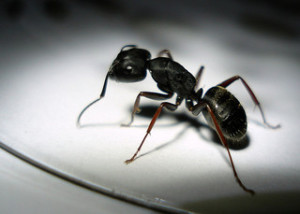Carpenter Ant Basics – What You Need to Know
By Chris Williams on December 24, 2014.
 If you see large ants crawling inside or around your home, you may have a carpenter ant nest nearby. Unlike termites, carpenter ants don’t eat wood, they excavate it to make their nest. Nevertheless, carpenter ants can cause serious structural damage to your home if left unchecked. In some parts of the country, like New Hampshire and Massachusetts, carpenter ants are considered to be as serious a pest as termites.
If you see large ants crawling inside or around your home, you may have a carpenter ant nest nearby. Unlike termites, carpenter ants don’t eat wood, they excavate it to make their nest. Nevertheless, carpenter ants can cause serious structural damage to your home if left unchecked. In some parts of the country, like New Hampshire and Massachusetts, carpenter ants are considered to be as serious a pest as termites.
Carpenter Ants and Damp Wood Go Together
Carpenter ants love moist wood. They usually (but not always) nest in wood that is damp or even wet. Indoors, the moisture may come from a leaky roof, overflowing rain gutters, poor ventilation in a crawlspace, or from a plumbing leak. Outdoors, carpenter ants commonly nest in old tree stumps, dead trees, logs, stacked firewood, old railroad ties, and other wood in contact with the ground.
Like other ants and termites, carpenter ants produce winged queens and kings that fly off in large swarms, usually in the spring. So carpenter ant colonies often start small, with a single queen flying in and starting a nest. On the other hand, a whole colony or a part of a colony can pick up and migrate to a new nest site, perhaps inside your home.
The Nest Can Be Inside, or Outside
Even if they are not nesting in your home, carpenter ants can be a nuisance when feeding on sweets, grease, crumbs, etc. in your kitchen. The worker ants often travel up to 100 yards from the nest looking for food, and are most active between ten at night and two in the morning. The ants infesting your kitchen may be nesting in your home or they may be coming from an old stump at the back of your yard.
Sometimes you can get rid of the carpenter ant problem yourself…say when you find a nest in an old stack of firewood. But most of the time, calling in a professional exterminator will be your most effective and convenient solution. Got carpenter ant questions? Give Colonial Pest a call!
Photo credit: sanchom / iW / CC BY
Stay up-to-date with Colonial Pest’s email newsletter!